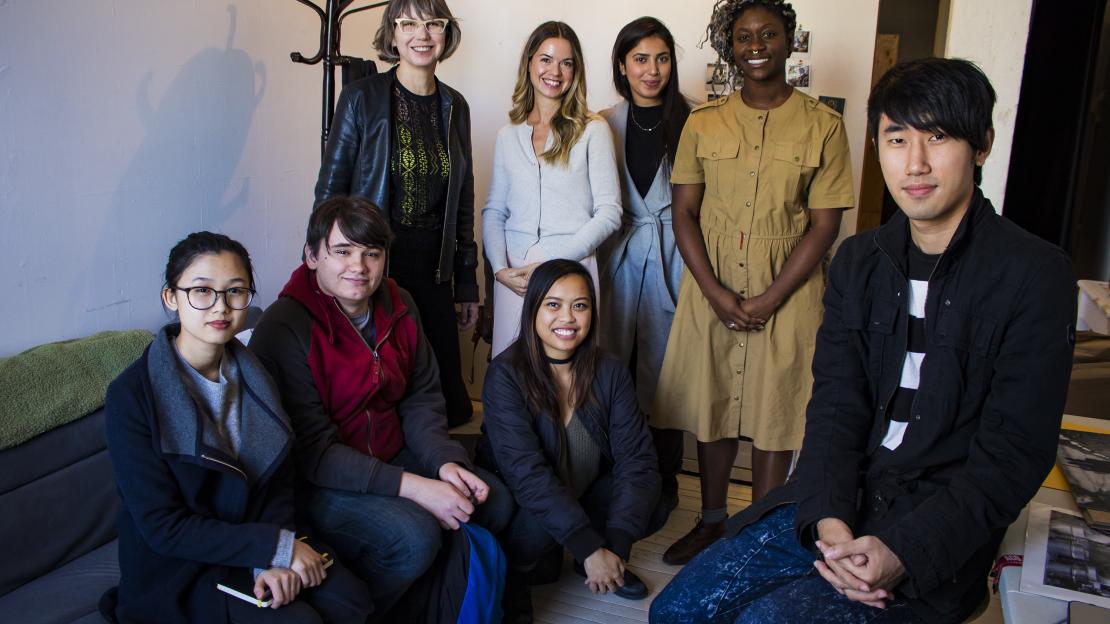Students in a U of T Scarborough art course were recently given a substantial budget and eight weeks to decide on a new acquisition for the university’s Doris McCarthy Gallery (DMG) collection.
After a semester-long search, the students in Curatorial Perspectives II final selection is Sixth Company Battalion [Group] by award-winning writer and multi-disciplinary artist, Anique Jordan. Sixth Company Battalion is a photo series inspired by Jordan’s family, who she discovered are descendants of Black Loyalists.
Seven students made the final decision after extensive research into the existing U of T Scarborough art collection and visits to the studios of five shortlisted artists – Rachel MacFarlane, Jordan, Erika DeFreitas, Rajni Perera and Tau Lewis. Each artist had to have significant roots in Scarborough, or their work reflects the cultural landscape of the Eastern GTA.
Watch Curatorial Perspectives II students visit the studios of five Toronto artists
Jordan, currently a curator at the Art Gallery of Ontario and the Executive Director of Whippersnapper Gallery, has previously conducted artist talks in the DMG through ACM Connects events, an artistic, cultural and scholarly programming initiative by the Department of Arts, Culture and Media.
For students, the course is an opportunity to put into practice skills learned in Curatorial Perspectives I, a prerequisite for Curatorial Perspectives II.
“When you’re learning in school, you don’t really understand all of the logistics that go into getting to know the artist and acquiring their work,” says Lynn Roeder, a fourth-year Specialist Degree in Arts Management student, during the Macfarlane visit.
Using critical skills developed in class, students questioned artists on artistic decisions, materials and techniques and greater meanings behind their works.
“An integral part of this course is that the students learn to be present, to listen to their speaker, process the information and formulate questions that are directly responsive to the content they’re getting in the moment,” says Ann MacDonald, Associate Professor teaching stream of Curatorial Perspectives II and DMG director.
Following each studio visit, students reflected on their studio visits and impressions through class assignments. In their final classes, they presented arguments for favoured works, discussions the pros and cons of pieces – including issues like maintenance, research value and more – before the last vote. After three hours of deliberation, the students settled on Jordan’s work, however the acquisition process is not over.
Once the class settled on their recommendation of Jordan’s work, students submitted a proposal to the Doris McCarthy Gallery acquisitions committee. Once approved it will then go to the U of T Art Committee before the possible acquisition can be made official.
Even after the work is hopefully acquired, it will not necessarily go straight to the DMG walls, says MacDonald.
“The work may be used for research purposes,” she says. “It may be installed elsewhere on the campus outside of the gallery so that those who don’t find their way into the gallery can encounter it on a daily basis, walking through the library, travelling the hallway.”
“We want to have art be a ubiquitous experience for our campus community.”
Curatorial Perspectives II is also part of Curatorial Studies, a minor program designed primarily for students majoring in Art History, Arts Management, Media Studies or Studio Arts programs. The course provides experiential learning opportunities, allowing students to get out into the community and visit artists’ studios that MacDonald says are essentially sacred spaces where artists do their own research, their own processing and create objects.
“It’s been life-changing, but not in a way that’s cheesy,” says Richard Macphee, a fourth-year Studio Arts major. “I think every student in this class is going to go forward with a new perspective on art and curation because of the experiences we’ve had.”
The Curatorial Perspectives II acquisitions fund was initiated by the Office of the Vice President U of T and Principal U of T Scarborough. It has since been supplemented by private donors.
“I am grateful for the support of such an innovative course,” says MacDonald. “It’s meaningful that students get out into the world, learn how to speak and engage with artists, and they come back, and select a work that will live on in perpetuity here on campus.”
More details about the possible acquisition will be released early 2018.
